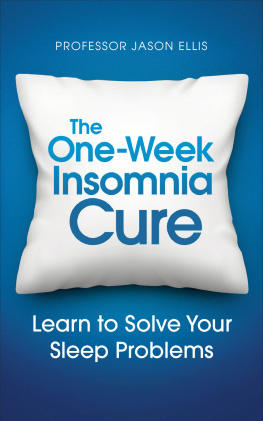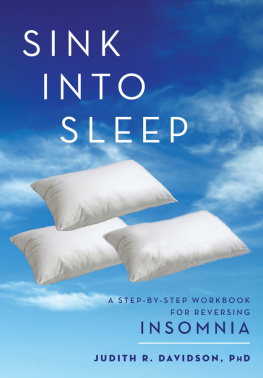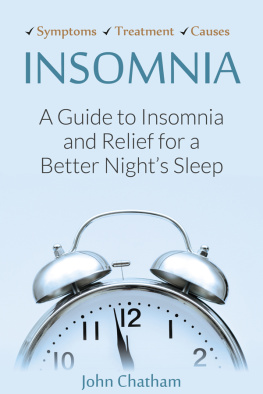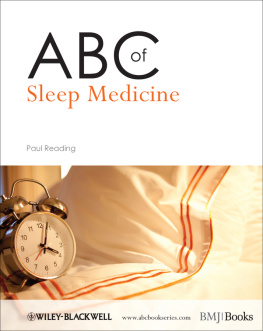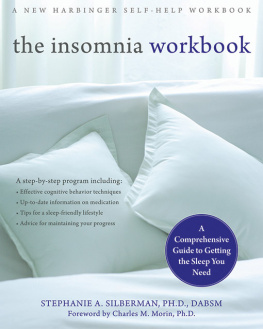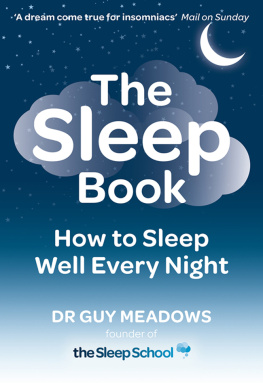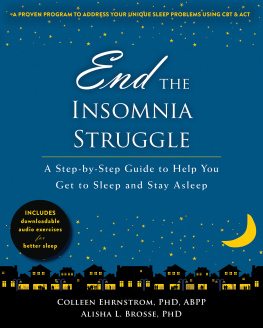Contents
Any references to writing in this book refer to the original printed version. Readers should write on a separate piece of paper in these instances.
About the Book
Beat your insomnia for good in just one week with the help and advice of one of the worlds only Sleep Scientists.
Based on over a decade of research and practise, Professor Jason Ellis shares the best techniques to alleviate the torment and exhaustion that a lack of sleep can bring. With a mixture of Cognitive Behavioural Therapy, Mindfulness and Interpersonal Therapy, The One-Week Insomnia Cure provides you with the tools for a perfect nights sleep.
- Understand and identify your sleep issues
- Stop dreading bed time and start reaping the benefits of sleep in just one week
- Find a solution to your snoring, sleep apnoea, restless legs and everything else that is keeping you from nodding off.
About the Author
Professor Jason Ellis PhD is Professor of Sleep Science and is the Director of the Northumbria Centre for Sleep Research at Northumbria University. He is a Practising Health Psychologist and one of a small handful of qualified Somnologist experts in Behavioural Sleep Medicine in the UK.
Foreword
I WILL BE upfront about one thing from the beginning, which, as you will see, I do a lot. The principles and techniques that this course is built upon are not mine. I have put together the best combination, including some tweaked versions of my own, of what I believe, have seen and have used when working with people with insomnia to bring about the change we need. Along those lines, and where possible, I have acknowledged who, I believe, is the originator of that theory, method or technique (even when I have tweaked their technique mercilessly). I would also point out that, although I have mentioned an individual or group of individuals with respect to a particular theory, technique or method, that is not the sole contribution that individual has, or continues to make, to the study and practice of Behavioural Sleep Medicine. Through their research, teaching and practice, each of those individuals has moved the awareness, acceptance and refinement of courses, like this one, forward immensely. That being said, the structure of this course and the tweaks are mine and I have found that this approach, although others may feel free to disagree, is the best way to bring about the change that we need and to abolish insomnia in the short term and prevent it from happening again in the future. The last thing I would like to say at this point is this. Whilst I do understand that the title of this book could be considered controversial, and some might question the use of the term cure, it is my belief that we can manage an individuals insomnia symptoms, using the techniques that I will outline, in a week. Additionally, I believe we can prevent a sleep disturbance from developing into insomnia in the future. As such, it is in essence what we are doing through the management and prevention strategies outlined here.
How to Use This Book
Part 1
IN PART 1 I will introduce you to some of the concepts that will help you understand what sleep is and how it works. The main purpose of Part 1 is that it will provide much of the groundwork for explaining why we will be doing the things that we do over the duration of the course. We will begin Part 1 by discussing the two main biological processes that affect when, where and how we sleep the sleep homeostat (the biological drive to sleep) and the sleep/wake circadian rhythm (the internal body clock). I am then going to demonstrate how sleep disturbances and most sleep problems are caused by a mismatch between the sleep homeostat, the sleep/wake circadian rhythm and/or the environment we find ourselves in.
From there, we will look more closely at what insomnia is and how it develops and we will go through a series of questions to determine whether you have insomnia and, if so, if the course is appropriate for you. After that, I will introduce the concepts of sleep-related conditioned arousal (the increasing levels of alertness and negative thoughts people with insomnia get when they get ready for bed or enter the bedroom) and cortical arousal (your natural awakening threshold in the night) and show how both of these forms of arousal relate to sleep quality (how you feel in the morning based upon how you slept the previous night).
Although all of that may just sound like a really boring intellectual exercise, this first section of the book and, in particular, the information about insomnia (what it is, how it is defined and how it develops) are important to work through carefully. However, the discussion after that Am I a Candidate for the Course? () is probably the most important of all. Here, we will be going through an algorithm to determine what, if any, factors you may need to take into account before you can start the course or, indeed, if the course is right for you at all. You should not proceed with any part of the course until you have been through the algorithm and, if need be, made some necessary adjustments or sought additional support or help.
Following that, we will talk about pre-planning and sleep hygiene. The pre-planning stage and the sleep hygiene advice that I provide are not included in Part 2, which is the one-week course, but can definitely, if managed well, improve both the chances of success and level of improvement you will see on completion of the course. Finally, at the end of Part 1 I will introduce you to the Pre-course Sleep Diary, which you must complete before you start the course.
It is my intention that, by the time you are finished with Part 1, you will have a pretty good idea about whether or not you meet all the criteria for insomnia and whether the course is right for you, right now, and whether you should proceed to ), as this may give you an initial idea of what kind of sleep problem you may have.
SOME DEFINITIONS
SLEEP DISTURBANCE, SLEEP PROBLEM AND SLEEP DISORDER
You may notice that I use the terms sleep disturbance and sleep problem throughout. As this is deliberate, it is worth me explaining why I do this now. I define a sleep disturbance as having a period of poor sleep for a short amount of time, usually anywhere between three nights and two weeks. The reason I do this is because it is my belief that a brief disruption to an individuals sleep, especially in the case of a sleep disturbance caused by a stressor, is actually biologically adaptive and perfectly normal. I will talk a lot more about that later. I use the term sleep problem when an individuals sleep has been poor for longer than two weeks but we dont know what the actual sleep problem is yet. Finally, later I will talk more about sleep disorders. In these instances, not only has the poor sleep been around for more than two weeks, but we have identified the problem(s), based upon an assessment of the main symptoms that the individual has and, indeed, that individuals sleep.
INSOMNIAC OR PERSON WITH INSOMNIA?
I never use the term insomniac but rather people with insomnia. There is a good reason for this. I absolutely hate the term insomniac. Although it may feel that insomnia is running your life, and that is a perfectly legitimate feeling, the term insomniac suggests that the insomnia defines who you are and that, to my mind, is simply not the case. It is something you have that needs to be dealt with, not part of your identity. We would not call someone with chronic pain a painiac so why the term insomniac has been entered into our vocabulary I really do not understand.

